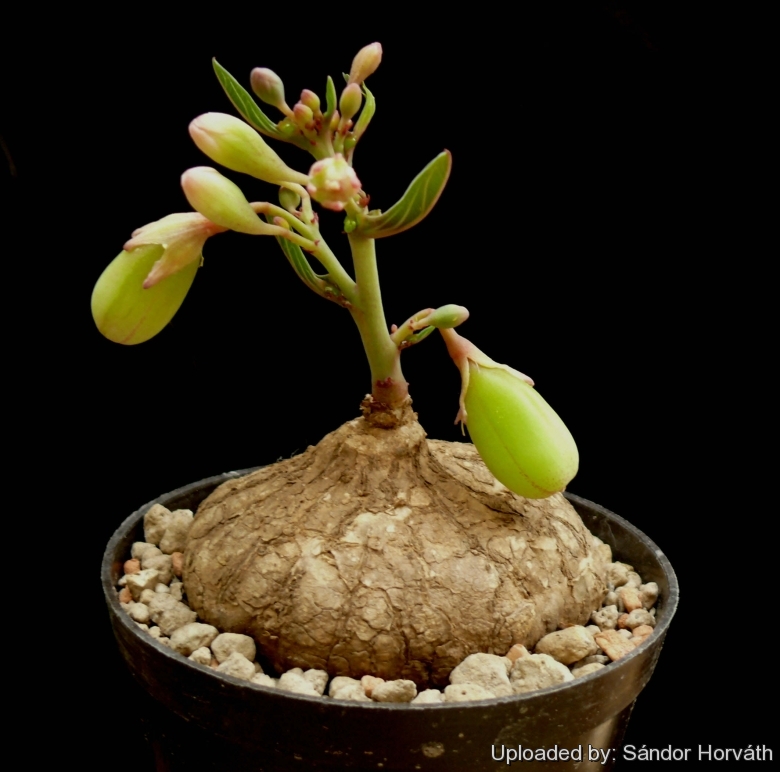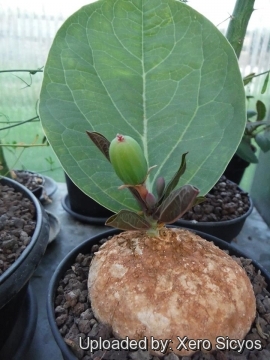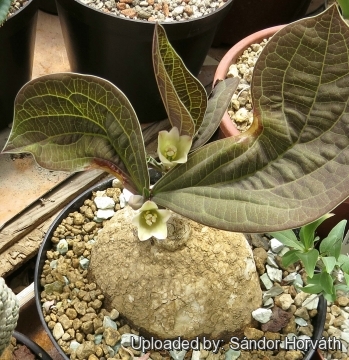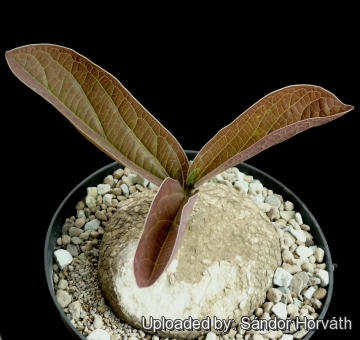




Your support is critical to our success.
Meded. Landbouwhoogeschool Wageningen 71(18): 204 1971.
Family: PASSIFLORACEAE

Origin and Habitat: Adenia ovataSN|32214]]SN|32214]] is only known from Zambia
Type Locality: Zambia, Mufulira, Fansetres
Altitude range: Around 1200 metres above sea level.
Habitat and ecology: This species occurs in Brachystegia woodland with continuous grass cover and variable woody cover. It grows on lateritic outcrops and dry loam-sandy soil. Adenia ovataSN|32214]]SN|32214]] is a geoxyle, a plant in which an enlarged, woody structure occurs beneath the surface of the ground from which emerge aerial shoots that may be ephemeral. This way they can escape damage from fire to some degree because in the dry season they are below ground level. Geoxyle plants are known as underground trees, and the areas where they grow as underground forests.
Synonyms:
- Adenia ovata W.J.de Wilde
Description: Adenia ovataSN|32214]]SN|32214]] is a suberect perennial herb, growing from a roundish tuber (caudex). The caudex can grow to eight centimetres in diameter, the entire plant to five or even ten centimetres in height, the stems are annual or partly perennial, 1-3 cm long. The caudex serves as a water reservoir in times of drought. The flowers are cream or pale yellow.
Tuber: Napiform warty.
Stems: Ephemeral or partly perennial, very short 1–3 cm long, internodes 2–10 mm apart.
Leaves: Flattened to the ground. Petiole 1–4 mm long. Blade 7–14 cm long, 5–12 cm broad, ovate to sub-circular, rounded or finely apiculate at the tip, cuneate at the base, leathery , brownish-green or greyish-green above, greyish-green purplish-red mottled beneath with (3)5(7) main nerves from the base and 3–4(7) pairs of secondary nerves from the midrib and distinct reticulation. Margin entire shortly. Stipules 2–4 mm long, narrowly triangular. Tendrils absent.
Inflorescence “cymes”: 1–10-flowered. Flowers both male, hermaphrodite and female, the flowers cream. Peduncle up to 4 mm long. Bracts and bracteoles 1.5–3.5 mm long, narrowly triangular. Pedicels 2–5 mm long in the hermaphrodite and female flower.
Hermaphrodite flower::(14)18–22 long, 4–7(8) mm wide, tubular-infundibuliform, tube 6–8 mm. long; calyx-lobes 3–5(7) mm long, ovate-oblong, petals 7–9 long, 1–1.5 mm wide, lanceolate. Corona consisting of hairs 1–2 mm long. Filaments 4–5 mm long, unitedat the base, anthers (1.5)2–4 long, 0.75–1.25 mm wide, disk-glands 0.33–1 mm long. Pistil 7–10 mm long, styles connate for about 1 mm, the arms 1–1.5 mm, ending in woolly-papillate stigmas.
Female flower: (12)17–19 long, 4–6(8) mm wide, tubular-infundibuliform, tube 5–6 mm long. Calyx-lobes 3.5–5 mm. long, oblong, petals (4)5–6 long, 1–1.5(2) mm wide, obovate to oblanceolate. Staminodes to 4 mm long with vestigial anthers. Disk-glands 0.5 mm long. Pistil 7–8 mm long, styles united at the base, ending in subglobular woolly-papillate stigmas.
Male flowers: Buds up to 10 mm long. Anthers 3–3.5 mm long including a long, vestigial ovary 1–1.5 mm long.
Fruits (capsules): Smooth, leathery, obovoid-oblong, 15–25 mm long, 10 mm broad.
Bibliography: Major references and further lectures
1) Arthur Wallis Exell, Hiram Wild, Abílio Fernandes “Flora Zambesiaca: Mozambique, Federation of Rhodesia and Nyasaland, Bechuanaland Protectorate” Vol 4, Published on behalf of the Governments of Portugal, the Federation of Rhodesia and Nyasaland, and the United Kingdom by the Crown Agents for Oversea Governments and Administrations, 1978
2) Bihrmann's Caudiciforms contributors Adenia ovata <http://www.bihrmann.com/caudiciforms/subs/ade-ova-sub.asp> Web. 5 January 2015
3) Adenia ovata de Wilde, “A Monograph of the Genus Adenia Forsk. (Passifloraceae)” 204 , Nov. 1971.
4) “Flore du Congo belge et du Ruanda-Urundi: Spermatophytes” Institut national pour l'étude agronomique du Congo belge, 1948
5) J.-P. LEBRUN & A. L. STORK (1991-2012). “Enumération des plantes à fleurs d'Afrique tropicale et Tropical African Flowering Plants: Ecology and Distribution”, vol. 1-7. Conservatoire et Jardin botaniques de la Ville de Genève.
6) “African Plants Database” (version 3.4.0). Conservatoire et Jardin botaniques de la Ville de Genève and South African National Biodiversity Institute, Pretoria, "Retrieved 05 January 2016 ", from <http://www.ville-ge.ch/musinfo/bd/cjb/africa/>.
7) P.S.M. Phiri “A checklist of Zambian vascular plants” Southern African Botanical Diversity Network Report No. 32 - 2005
8) Olivier Maurin, T. Jonathan Davies, John E. Burrows, Barnabas H. Daru, Kowiyou Yessoufou, A. Muthama Muasya, Michelle van der Bank and William J. Bond “Savanna fire and the origin of the 'underground' forest of Africa” <http://repository.up.ac.za/bitstream/handle/2263/49453/Maurin_Savanna_2014.pdf?sequence=1
9) Wikipedia contributors. "Geoxyle." Wikipedia, The Free Encyclopedia. Wikipedia, The Free Encyclopedia, 27 Apr. 2015. Web. 5 Jan. 2016.

Adenia ovata Photo by: Xero Sicyos

Adenia ovata Photo by: Sándor Horváth

Adenia ovata Photo by: Sándor Horváth
The gallery now contains thousands of pictures, however it is possible to do even more. We are, of course, seeking photos of species not yet shown in the gallery but not only that, we are also looking for better pictures than those already present. Read More...
Cultivation and Propagation: Beloved by collectors, Adenia ovataSN|32214]]SN|32214]] is an excellent pot plant and it should make an interesting addition to a collection.
Growth rate: It grows well, though very slowly, but it possible to increase the speed of growth to some extent by providing adequate amount of water, warmth, and fertilizer during the active growing season, but it’s susceptible to rotting if too wet.
Exposure: It needs light shade. Avoid direct blasting sun in summer. Bright light if grown indoors.
Soil: It needs a very porous potting medium (add pumice, vulcanite, and perlite). It does better in a rather acidic soil.
Waterings: Water frequently while plant is in full growth, but keep dry during the winter after the branches have died back. It rot easily and do NOT like a lot of water when it has no leaves.
Fertilizer: Benefits from moderate doses of a well-balanced, slow-release fertilizer.
Frost tolerance: Due to its African origin keep warm in winter, the minimum safe average temperature is 15°C, although it can go lower for short periods. It can be grown outdoors in frost-free climates, need anyway to kept above 10°C and dry in winter. It is very prone to rot in cool, wet conditions. USDA Zone 12, but does very well in containers.
Maintenance: Repot every two years. It like pots with generous drain holes.
Propagation: The species can be propagated by both seeds and cuttings. The plants for seed production are generally grown from cuttings since these bloom more freely. The plants for decoration are grown from seed since they develop a caudex.
Warning: As with all Adenias, all parts of this plant are very toxic, and they should be handled with caution, particularly when pruning.
| Your Actions | |
|---|---|
| Back to Adenia index | |
| Back to Passifloraceae index | |
 |
Back to Cacti Encyclopedia index |
Privacy stantement - Terms and conditions - How to cite - About us - Feedback - Donate



